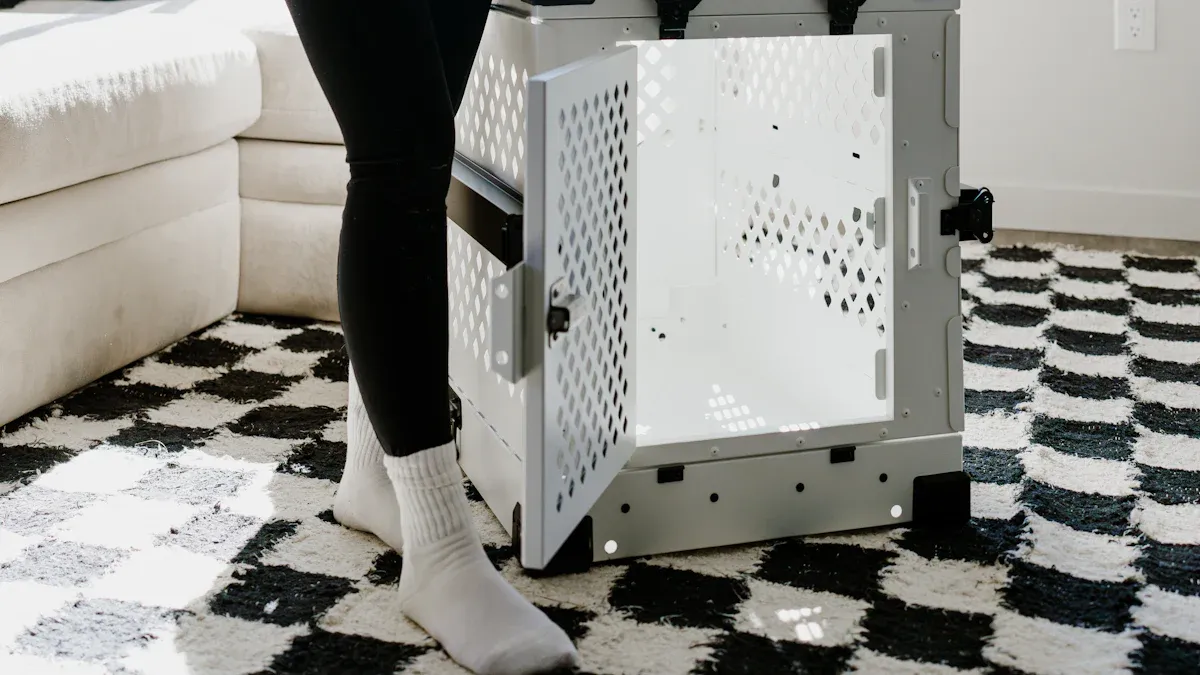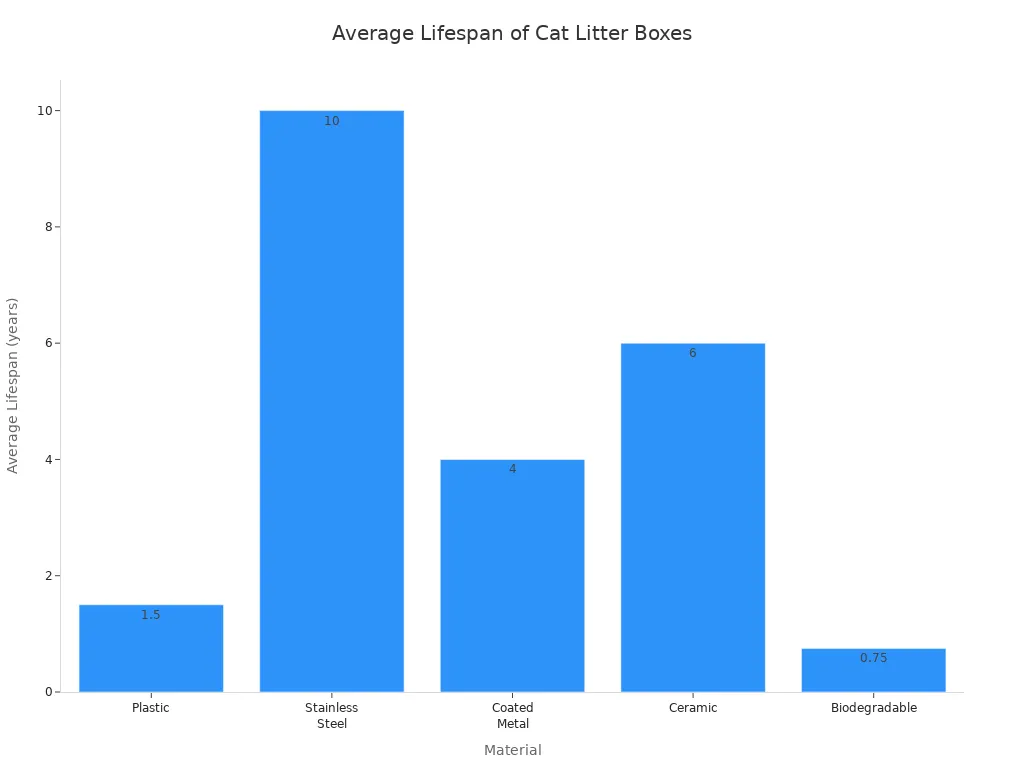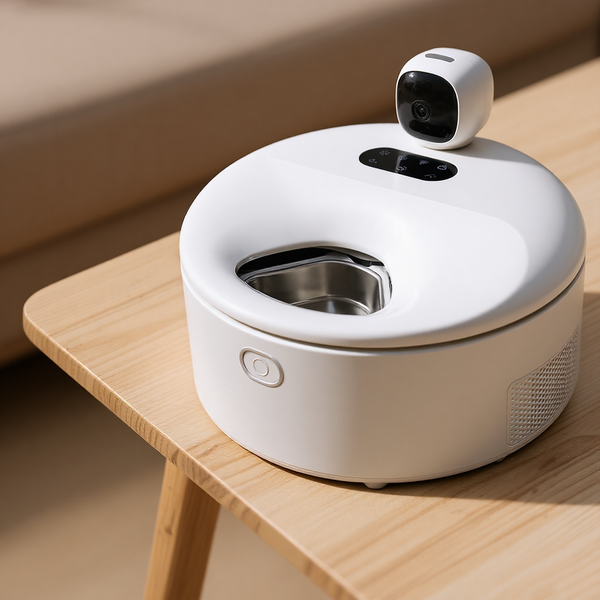
If you want a cleaner, longer-lasting litter box, a stainless steel cat litter box could be worth your money in 2025. You pay more upfront—prices often range from $89.90 to $99.99, while plastic boxes cost much less. But you get better durability, less odor, and easier cleaning. Many cat owners also care about eco-friendliness, and stainless steel stands out here. Think about what matters most to you and your cat.
-
Stainless Steel Litter Boxes: $89.90–$99.99
-
Plastic Litter Boxes: Much cheaper
Key Takeaways
-
Stainless steel cat litter boxes are very strong. They can last more than 10 years. This makes them a good choice for the future.
-
These boxes help control bad smells well. Stainless steel does not soak up odors. Your home will smell better.
-
Cleaning stainless steel is fast and simple. It does not let bacteria or stains stick. You save time and work.
-
Think about your budget and what you need. Stainless steel costs more at first. But you may spend less later because you buy fewer replacements.
-
If you care about the planet, stainless steel is recyclable. It is better for the environment than plastic.
Are Stainless Steel Cat Litter Boxes Worth It?
Quick Verdict for 2025
If you want a litter box that lasts, stays cleaner, and helps control odors, a stainless steel cat litter box is worth considering in 2025. You pay more upfront, but you get a product that resists scratches and keeps its shape. Many cat owners say they spend less time scrubbing and replacing their boxes. You also help the environment because stainless steel is recyclable.
Still, you should know about a few drawbacks. Stainless steel cat litter boxes cost more than plastic ones. They feel heavier, especially when filled with litter. Some cats may not like the sound of litter scratching against metal. Take a look at the most common concerns from recent surveys:
|
Concern |
Description |
|---|---|
|
Stainless steel litter boxes are generally more expensive than plastic options. |
|
|
Weight |
They are heavier, making them more difficult to move when filled with litter. |
|
Noise |
The sound of litter scratching against metal can be louder, which may disturb sensitive cats. |
Tip: If you want fewer odors and easier cleaning, stainless steel might be the best choice for you.
Who Should Consider One?
You might want a stainless steel cat litter box if you have more than one cat or if your cat is picky about cleanliness. These boxes work well for people who want to avoid plastic and prefer eco-friendly products. If you hate scrubbing stains or replacing cracked boxes, stainless steel saves you time and effort.
-
You care about durability and want a box that lasts for years.
-
You want better odor control and easier cleaning.
-
You prefer eco-friendly options over plastic.
-
You have a cat with allergies or sensitive skin.
-
You want to invest in quality pet essentials, just like you would with smart feeders or other premium products.
If you only need a basic box and want to save money, plastic might work better for you. But if you value long-term savings and a cleaner home, stainless steel stands out.
Stainless Steel Cat Litter Box Benefits
Durability
You want a litter box that lasts. A stainless steel cat litter box stands out for its strength. It resists rust, stains, and scratches. You do not have to worry about warping or cracks. Many users say the surface feels almost nonstick, so cleaning is easier. Take a look at how different materials compare:
|
Material |
Average Lifespan |
Odor Retention |
Scratch Resistance |
Warping Risk |
|---|---|---|---|---|
|
Plastic |
1-2 years |
High |
Low |
High |
|
Stainless Steel |
10+ years |
None |
High |
None |
|
Coated Metal |
3-5 years |
Medium |
Medium |
Low |
|
Ceramic |
5-7 years |
Low |
High |
Medium |
|
Biodegradable |
6-12 months |
High |
Low |
High |

Odor Control
No one likes a smelly litter box. You will notice a big difference with stainless steel. Unlike plastic, it does not absorb odors. The surface stays fresh, even after many uses. Many cat owners report that their homes smell cleaner. You do not have to scrub away stains that trap bad smells. Some popular models, like the iPrimio Non-Stick Plated Stainless Steel XL Litter Pan, get high marks for keeping odors away.
-
Stainless steel does not absorb odors.
-
Plastic boxes can trap smells and develop stains.
-
You get a fresher environment for your cat.
Hygiene and Cleaning
Keeping your cat’s litter box clean is important. Stainless steel is naturally resistant to bacteria. You can wipe it down quickly, and it stays cleaner longer. The smooth surface helps prevent germs from spreading. You spend less time scrubbing and more time enjoying your pet.
-
Stainless steel resists bacteria and smells.
-
You help prevent the spread of germs.
-
Maintenance is simple and fast.
Tip: If you want less mess and easier cleaning, stainless steel makes your life easier.
Eco-Friendly Choice
You care about the planet. A stainless steel cat litter box is recyclable. Plastic boxes can take hundreds of years to break down. Stainless steel offers a greener option for pet owners who want to reduce waste. You make a smart choice for your cat and the environment.
Drawbacks to Know

Higher Cost
You might notice the price tag first. Stainless steel cat litter boxes cost more than plastic ones. You pay extra for durability and better hygiene. Many cat owners see this as a smart investment. They like that stainless steel lasts longer and stays cleaner. You also help the planet by choosing a recyclable material. Here’s what other cat owners say:
-
You get a litter box that resists wear and tear.
-
Cleaning feels easier because the surface does not trap dirt.
-
You lower health risks for your cat and yourself.
-
Eco-friendly choices matter to you.
Still, if you want to save money right now, plastic boxes seem more affordable. You need to decide if long-term value is worth the upfront cost.
Weight and Handling
Stainless steel feels heavier than plastic. You may find it harder to lift or move, especially when filled with litter. If you clean the box often or need to carry it between rooms, this can be a hassle. Some people prefer lighter options for quick cleaning. You should think about your own routine and strength before buying.
Noise Issues
Noise can surprise you. When your cat scratches or digs, stainless steel makes a louder sound than plastic. Some cats do not mind, but others feel startled. If you live in an apartment or have sensitive pets, noise matters. Take a look at how different materials compare:
|
Material |
Noise Level Reduction |
User Feedback |
|---|---|---|
|
Stainless Steel |
High |
Quieter operation reported by users |
|
Plastic |
Low |
Common complaints about noise |
|
|
|
You might want to test how your cat reacts before switching.
Limited Styles
You get fewer choices with stainless steel. Most boxes look simple and shiny. If you want bright colors or fun shapes, plastic offers more variety. Stainless steel focuses on function, not fashion. You may need to compromise on style for better performance.
Note: If you care most about durability and hygiene, style may not matter as much. If you want a box that matches your home, you might prefer plastic.
Choosing a Stainless Steel Cat Litter Box
Size and Depth
Picking the right size and depth makes a big difference for your cat’s comfort. You want a box that matches your cat’s body length from nose to tail. If you have a big cat, go for an extra-large box. For kittens or older cats, low sides help them get in and out easily. Most cats like a shallow layer of litter—about two to three inches deep. Here’s a quick guide:
|
Recommendation Type |
Details |
|---|---|
|
Box Size |
Length should match your cat’s body from nose to tail. |
|
Low Sides |
Best for kittens and senior cats for easy access. |
|
Litter Depth |
Two to three inches of litter is ideal for most cats. |
Non-Slip Features
You don’t want the litter box sliding around when your cat jumps in. Look for rubber feet or non-slip pads on the bottom. These features keep the box steady and help prevent spills. Some boxes even have textured bases for extra grip. This makes cleaning easier and keeps your floors tidy.
Rust Resistance
A good stainless steel cat litter box should resist rust, even after years of use. High-quality stainless steel stands up to moisture and cleaning. You can wipe it down or rinse it without worrying about damage. This means your box stays safe and looks new for a long time.
Easy-to-Clean Design
Cleaning should be quick and simple. Many new boxes in 2025 come with smart features like self-cleaning systems, odor-trapping lids, and even sensors that tell you when to scoop. Some have antimicrobial coatings to stop bacteria from growing. Look for smooth surfaces and rounded corners so nothing gets stuck. Here are some cleaning innovations you might see:
|
Feature |
Description |
|---|---|
|
Self-cleaning mechanisms |
Automated systems that scoop waste for you. |
|
Advanced filtration |
Lids and filters that trap odors and keep things fresh. |
|
Smart technology |
Sensors that alert you when it’s time to clean or add litter. |
Tip: Investing in quality pet products, like a stainless steel cat litter box or the Polar Smart Wet Food Feeder from Petcantalk, can make daily care easier and more enjoyable for you and your pet.
Stainless Steel vs. Other Litter Boxes
Plastic
Plastic litter boxes are everywhere. You probably see them in every pet store. They cost less and come in lots of shapes and colors. If you want something cheap and easy to replace, plastic might seem like the best choice. But plastic has some downsides you should know about. It scratches easily, so bacteria and odors can hide in those tiny grooves. Over time, you may notice stains that just won’t come out. You might find yourself buying a new box every year or two. Cleaning takes more effort, and smells can linger even after you scrub.
|
Feature |
Stainless Steel |
Plastic |
|---|---|---|
|
Durability |
Lasts decades |
1-2 years |
|
Odor Control |
Excellent |
Poor |
|
Hygiene |
High |
Low |
|
Maintenance |
Easy |
Frequent |
|
Eco-Friendly |
Recyclable |
Not recyclable |
Tip: If you want less hassle and fewer replacements, stainless steel wins on durability and hygiene.
Enamel-Coated
Enamel-coated litter boxes look fancy. They have a smooth finish and sometimes come in bright colors. You might like the style, but enamel can chip or crack if you drop the box or your cat scratches hard. Once the coating breaks, cleaning gets tougher. Bacteria and odors can sneak into those cracks. Enamel boxes last longer than plastic, but not as long as stainless steel. You still need to check for chips and replace the box if it gets damaged.
What Matters Most
Choosing the right litter box depends on what you care about most. Do you want something that lasts? Are you tired of fighting odors? Maybe you want to help the planet by cutting down on waste. Experts say you should look at these factors:
-
Durability: Stainless steel lasts for decades. Plastic needs frequent replacement.
-
Hygiene: Stainless steel is easy to clean and does not trap bacteria.
-
Odor Control: The non-porous surface of stainless steel resists odor absorption.
-
Maintenance: Stainless steel requires minimal upkeep.
-
Eco-friendliness: Stainless steel is 100% recyclable.
-
Overall Value: Stainless steel costs more at first, but saves you money over time.
You know your cat best. Think about your routine, your budget, and what makes life easier for you. Stainless steel stands out if you want a box that stays clean, lasts for years, and keeps your home smelling fresh.
Is It Right for You?
Budget and Priorities
You want the best for your cat, but you also need to think about your wallet. Stainless steel cat litter boxes cost more than plastic ones. You pay a higher price upfront, but you get a box that lasts for years. If you replace plastic boxes often, you might spend more money over time. Stainless steel saves you from buying new boxes every year.
Ask yourself a few questions:
-
Do you want a litter box that stays clean with less effort?
-
Are you tired of bad smells in your home?
-
Is durability important to you?
-
Would you rather invest once and avoid frequent replacements?
If you answer yes to most of these, stainless steel might fit your needs. You also help the planet by choosing a recyclable product. Some pet owners like to spend more on essentials that make life easier, just like they do with smart feeders or other high-quality pet gear.
Here’s a quick table to help you decide:
|
Priority |
Stainless Steel Box |
Plastic Box |
|---|---|---|
|
Upfront Cost |
Higher |
Lower |
|
Long-Term Savings |
Yes |
No |
|
Eco-Friendly |
Yes |
No |
|
Odor Control |
Excellent |
Poor |
|
Durability |
Lasts years |
Needs replacing |
Real User Experiences
You don’t have to take my word for it. Cat owners in 2025 share their stories about stainless steel litter boxes. Many say they love how easy it is to clean. They notice fewer smells in their homes. Owners with big cats appreciate the roomy design. Accessories like scoops and liners make things even better.
Here’s what users say:
-
They find the box strong and scratch-resistant.
-
Cleaning takes less time and effort.
-
Odor control works well, keeping homes fresh.
-
Spacious design fits larger cats comfortably.
-
Included accessories add convenience.
Tip: If you want a litter box that makes daily care simple and keeps your cat happy, stainless steel gets high marks from real users.
You know your budget and what matters most to you. Listen to other pet owners and think about your own routine. Stainless steel might be the upgrade you and your cat deserve.
Stainless steel cat litter boxes offer durability, easy cleaning, and strong odor control. You pay more upfront, but you get a box that lasts for years. Some drawbacks include higher cost, heavier weight, and fewer style choices.
-
Think about your budget and what matters most for your cat.
-
Compare your options before you buy.
Tip: If you want less mess and more convenience, stainless steel could be the upgrade your home needs.
FAQ
How do you clean a stainless steel cat litter box?
Cleaning is easy. Just scoop out the litter, rinse the box with warm water, and wipe it down. You can use mild soap if you want. Stainless steel does not hold stains or smells.
Will stainless steel rust over time?
No, high-quality stainless steel resists rust. You can use it for years without seeing any rust spots. Make sure you dry the box after washing to keep it looking new.
Is a stainless steel litter box safe for kittens?
Yes, stainless steel is safe for kittens. The smooth surface does not scratch or hurt their paws. You can choose a box with low sides so kittens can climb in and out easily.
Do stainless steel litter boxes help with odor control?
Absolutely! Stainless steel does not absorb smells. You will notice your home stays fresher. Many cat owners say they smell less odor compared to plastic boxes.




